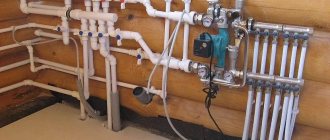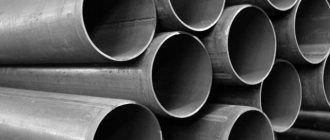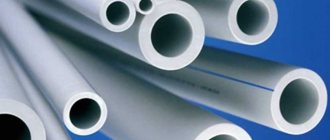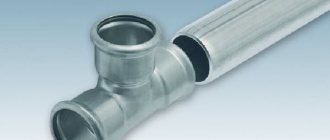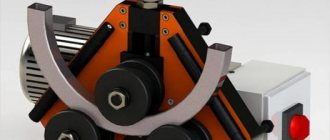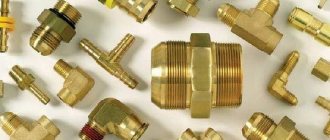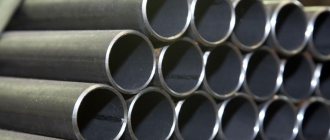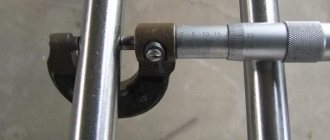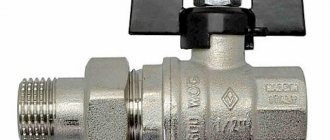When designating products, for example, a copper pipe with a diameter of 8 mm, we mean one of the main parameters of pipes - the outer diameter. Many properties of the future pipeline (working pressure, length, etc.) depend on this indicator. It is necessary to be able to operate with quantities such as inches and millimeters, since according to GOST, they are the main measures of this parameter. The digital equivalent of the values of parameters such as length and diameter is often used in formulas for various calculations.
Today, we can distinguish the following diameters of copper pipes, which, one way or another, appear in the tables:
- External;
- Interior;
- Nominal.
The very need for comparative tables with diameters arose due to different standards in Russia and Europe (All products related to copper pipes:). Since most pipe manufacturers are foreign, the characteristics use inches, while in our territory they operate with mm values, see.
| Ø, inch | Outer diameter + wall thickness, mm |
| 1/4 | 6.35+0.76 |
| 3/8 | 9.52+0.81 |
| 1/2 | 12.7+0.81 |
| 5/8 | 15.9+0.90 |
| 3/4 | 19.05+0.89 |
| 7/8 | 22.23+1.14 |
| 1 | 25.4+1.14 |
| 1 1/8 | 28.58+1.27 |
| 1 3/8 | 34.93+1.40 |
| 1 5/8 | 41.27+1.53 |
| 2 1/8 | 53.98+1.78 |
| 2 5/8 | 66.68+2.03 |
| 3 1/8 | 79.39+2.30 |
| 3 5/8 | 92.08+2.54 |
| 4 1/8 | 104.74+2.80 |
Features of copper pipes
These products are manufactured using seamless production technology. The material for copper products does not enter into chemical reactions, it is impermeable to various types of liquids, such as fats, oils, and does not contribute to the proliferation of viruses and bacteria.
It is known that tap water contains chlorine, but it does not contribute to the destruction of copper pipes, but promotes the formation of a protective layer on their inner surface against oxidative processes, which gives the pipelines increased stability and strength.
By analogy with plastic products, copper pipe products almost do not form build-ups of all kinds of deposits, such as limescale, for example. According to the provisions of GOST, a copper pipe can be in working condition at a temperature range between -200 and +250 degrees. These products are very resistant to sudden temperature changes, since they are characterized by a low coefficient of thermal expansion.
Copper pipes, when water freezes in them, remain intact and in a sealed state. Unlike plastic pipe products intended for water and heat supply, copper products are not dangerous from ultraviolet radiation. They are painted not so much to protect the pipeline, but to give it an appropriate appearance. Today, in order to increase the attractiveness of copper products, chrome-plated products are produced from this material.
Since such pipes are characterized by a low roughness index compared to products made of metals and polymers, under equal conditions it is possible to lay a pipeline of a smaller cross-section.
Tables of water pipe sizes in mm and inches
Every person who installs or repairs water pipes will have to become familiar with the dimensions of water pipes in mm and inches. Without this, it will not be possible to achieve high-quality connections and the required pipeline capacity. Let's look in more detail: why there are two measurement systems and how sizes are recalculated.
Classification of water pipes
Historically, measurements were calculated in inches. This meaning differed in each state. It was conventionally equated to:
- the width of the index finger;
- the length of three barley grains from the middle of the spikelet;
- the ratio of the distance from the tip of the nose to the thumb of the outstretched hand of King Henry 1 of England.
As a result of the development of civilization and relationships between states, people realized that it was inconvenient to use such a value for full-fledged trade. For this reason, everyone switched to a common measuring system and distances began to be measured in meters.
The value of the current meter was fixed in 1983 at the XVII General Conference on Weights and Measures. At this stage it is tied to the speed of light. Despite this, diameters in water pipes continue to be measured in inches.
It is officially recognized that this unit is equivalent to 0.0254 meters, or 25.4 mm.
Main dimensions
Each water pipe has a diameter and other individual dimensions:
- internal distance between walls;
- the size of the required passage;
- nominal diameter;
- external thickness;
- wall thickness.
The throughput and profitability of the entire water supply system depends on these values. When designing, installing and repairing it, you must be especially careful to comply with these dimensions. A discrepancy of 1 mm at one connection can lead to failure of the entire structure.
Table of water pipe diameters
Pipes are qualified according to their external size, which is specified by the manufacturer. To determine the internal diameter, you will need to subtract twice the wall thickness from the external value.
However, products made of cast iron and steel are marked by internal diameter, taking into account their throughput. This should be remembered when using products made from different materials in the same system.
Let's look at a few examples.
Steel pipe 76x3 means:
- outer diameter of the product 76 mm;
- wall thickness 3 mm;
- the internal passage will be 70 mm.
The calculation was as follows: 76 - (3x2) = 70 mm.
1" copper pipe implies an outer thickness of 1 inch, or 25.4 mm.
Fittings are used to join products made of different materials.
To connect a metal and plastic pipe, the fittings will have plastic on one side, which will allow for high-quality soldering, and on the other, threads for a reliable threaded connection.
To do this, you need to pay attention to the thread size and pitch. When connecting to cast iron, sockets and special seals are used. Plastic can be soldered together, metal can be welded using electric or gas welding.
Steel
Steel pipe size chart
When installed with steel products, their selection is made according to the outer diameter of the water supply system pipe. According to the requirements of GOST 10704–91, they are divided into groups:
- large diameter - from 508 mm;
- medium – 114-530 mm;
- small – up to 114 mm.
In home plumbing, the most popular products are those with small sizes. Medium - in the city water supply. Large - for main oil and gas pipelines. The most popular products include:
- ½” - 12.7 mm;
- ¾” - 19.0 mm;
- 1” - 25.4 mm;
- 1½” - 38.1 mm.
Specialists who are involved in laying and repairing water pipes on a daily basis know these values by heart, while others look them up in tables.
Cast iron
Cast Iron Pipe Size Chart
These products are used when laying street water supply networks. Their use indoors is limited. They have long-lasting operation and increased strength.
However, they are fragile and are susceptible to impact. Disadvantages include significant weight and high cost.
The size of the pipe for such a water supply system is calculated according to the internal throughput of the product.
Plastic
Modern technologies make it possible to produce high-quality plastic that is sufficiently durable, lightweight, does not corrode, and is an environmentally friendly material. Thanks to these characteristics, it displaces metal and cast iron from the construction market; its cost is significantly lower than these materials. The most popular materials are:
Plastic pipe size chart
- polyethylene - is the cheapest option, used for technical water supply in utility rooms;
- polypropylene - requires special equipment for soldering, well suited for cold water supply in the house;
- metal-plastic - one of the highest quality in this segment, used in cold and hot water supply indoors.
Nominal wall thickness of PP-R pipes
The size of these products leaves much to be desired.
The problem is that each manufacturer sets its own sizing chart. Therefore, when assembling a plastic water supply system, it is advisable to purchase all components from one manufacturer. Or you will have to take measurements of each product. Despite this, plastic pipelines are distinguished by their performance characteristics and are very popular, especially when laying water distribution indoors.
How to correctly convert mm to inches
Standard sizes of welded and seamless steel pipes Table of conversion of water pipe diameters from inches to millimeters
When laying a water supply system or replacing its elements, it is necessary to be well versed in their relationships. To carry out these translations, masters use special tables. The difficulty lies in the wall thickness. An illustrative example:
- Let’s take a product with an outer thickness of 1”, which should be equal to 25.4 mm;
- the diameter of the threaded connection will be 33.249 mm.
How to calculate the diameter of a pipe for a water supply? The thread is cut on the outside of the wall. Its nominal value in relation to the internal indicator is obtained by a symbol. Therefore, to calculate it it is necessary: to 25.4 mm add double the wall thickness of the product. The result will be 33.249 mm. Common threaded connections:
- ½” - 20.4…20.7 mm;
- ¾” - 25.9…26.2 mm;
- 1” - 32.7...33.0 mm;
- 1½” - 45.8…46.2 mm.
As you can see, each case has its own discrepancies.
Conclusion
When installing a water supply system or replacing its elements, it is necessary to strictly observe the diameter of the water supply pipes. Otherwise, at the slightest discrepancy of up to 1 mm, the density and strength of the hermetic connection will be in question. Such a connection cannot be considered reliable and at any moment can lead to failure or leakage.
Did you find this article helpful? Give it a thumbs up!
Please subscribe to the CHANNEL
Scope of application of copper pipelines
The scope of use of copper pipe products is extensive, but most often it is used for laying:
- heating systems;
- pipelines for water supply;
- highways along which compressed air or gas is transported;
- fuel pipelines;
- condensate drainage systems;
- structures for connecting technological equipment;
- pipelines supplying freon to refrigeration units;
- air conditioning systems, etc.
Methods for producing copper pipe products
Copper pipe sizes vary. When arranging systems for household purposes, two types of copper products are usually used:
- unannealed;
- annealed.
The first type of pipes is sold in straight sections ranging from 1 to 5 meters in length.
In the second case, the products undergo heat treatment - they are fired, after which they become soft, and the strength characteristics are slightly reduced, but the installation of copper fittings becomes easier. Annealed pipes are sold to consumers in lengths from 2 to 50 meters, packaged in coils.
In addition to products with round sections, manufacturers produce rectangular products. Due to their non-standard shape, such pipes are difficult to manufacture and therefore their cost is higher compared to conventional products.
Regulatory requirements according to GOST
External parameters, mechanical characteristics, alloy composition, assortment and marking designations are regulated by two main provisions: GOST 617-2006 (General purpose copper pipes) and GOST 11383-75. European-made products meet the EN-1057 standard of 2006.
Set of requirements:
- The internal and external surface of the pipe should not be contaminated to prevent inspection of the products. The presence of delaminations, rust, cracks and cavities on the pipe “sleeve” is unacceptable.
- A dent up to 0.25 mm deep is acceptable. The quantity limit is no more than two per linear meter and no more than 10% of defective products per delivery lot.
- No burrs at the ends of the pipes. The normalized cutting bevel for specimens with a diameter of up to 20 mm is 2 mm, for products with a cross-section of 20-170 mm - 3-5 mm, respectively, for pipe fittings with a diameter of 170 mm or more, a bevel of 7 mm is acceptable.
- For coils and soft pipes, ovality is not limited.
Each coil or batch of pipe sections must be accompanied by a packing slip and information label.
Mandatory data from the accompanying document: trademark of the enterprise, legal address of the manufacturer, marking of the composition and dimensions of pipes, batch number, production date, technical control stamp
Features of installation of copper pipelines
Before you begin creating a copper pipeline, you should take the necessary measurements and cut the pipes into pieces. The cut of the product must be even, so a special cutter is used. By the way, copper pipes are not threaded.
Connecting individual sections of a copper pipeline can be done in the following ways:
- soldering method;
- pressing.
The most effective of them is considered to be joining using capillary soldering technology, which is why it has become more widespread. This method ensures reliability and absolute tightness of pipe joints. Square copper products are connected using capillary soldering, which is performed using fittings and sockets.
This method of laying pipelines from copper components is used when the pipeline is planned to be operated in conditions of extremely high temperatures.
Joining by pressing involves the use of different types of fittings, including compression and self-locking. Special flanges and clamps are also used to provide the screed. Pressing is used in cases where the pipeline cannot be exposed to open flame.
Fittings for copper pipe products
For laying copper pipelines, crimp or solder type fittings are used. The first type of connecting elements is usually made of brass. The tightness of such a connection is ensured by the presence of a crimp ring located inside the fitting, which is tightened with a wrench. A compression fitting is used to connect pipes of different diameters at the site where the pipeline is laid, provided there is access to check the tightness (for more details: “Which compression fittings for copper pipes are best to use, rules for choosing compression fittings and installation”).
Such parts are usually used when it is necessary to lay a line designed for operation when the working medium moves through it under low pressure. At the same time, during the operation of the pipeline, it is necessary to periodically monitor the condition of the fittings.
The connection process is performed in the following sequence:
- The fitting is disassembled into its component parts.
- The clamp nut and ferrule are placed on the pipe.
- The end of the pipe, which has a ring and a nut, is inserted into the fitting.
- The nut is fixed all the way, and the cone-shaped ring must be inserted into the cone part without distortion.
- The nut is tightened with a wrench by 0.5-1.25 turns - which depends on the diameter of the pipe used.
When performing work, the main thing is not to overdo it, since if you apply too much force, you can damage the wall of the pipe product.
The type of connection described above cannot be called flawless - compression fittings often leak, so their condition should be constantly monitored.
Process steps
Let's consider the process step by step for different connection options.
Low temperature soldering connection
Experts say that for such work you need to purchase low-melting solder and low-temperature flux. The gas burner can be filled with a mixture that includes propane, air or butane.
The flame must be directed strictly along the pipe seam, moving across the entire joint area. This is done to ensure uniform heating of all areas. Do not forget to periodically coat the gap with solder, it will gradually begin to melt. As soon as melting begins, you need to remove the burner, and the substance will fill the capillary gap. When the gap is completely filled, the parts need to cool under normal conditions, without temperature changes. A connection that has not cooled down must not be touched.
Sometimes it is not recommended to solder any products; in such cases, preference is given to welding. The process is practically no different from soldering. But before you move on to the welding process, familiarize yourself with the safety rules and work flow. You will need safety glasses.
High temperature soldering
The composition of the gas burner filler is changing; now it is filled with propane with oxygen or acetylene with air. Warming up should not take much time, the device should produce a blue flame.
The flame, as in the case of low-temperature soldering, must be applied across the entire joint, changing the position of the burner. When the metal reaches approximately 750 degrees, it will turn a dark red color. At this moment you need to use solder, you can heat it with a burner. However, the solder should ideally be heated away from the part.
The product must be given a temperature at which the solder will quickly melt and fill the space between the parts. After complete filling, you need to leave the structure to cool.
Repair
You can fix problems with your plumbing or household appliances, such as a refrigerator or split system, with your own hands.
Metal delamination is a common problem. In this case, high-temperature soldering is used, this will significantly extend the service life of the system. A common occurrence is the appearance of cracks in pipe bends. Craftsmen recommend using low-temperature welding.
In repairs, it is also necessary to clean the surfaces before starting work, otherwise the structure will quickly fail. If the fitting leaks, you will have to cut out this part of the pipe and solder a new one with a new coupling. If a nut or gasket breaks, it is enough to replace only this part.
Safety precautions
Copper has a high thermal conductivity, so you must wear mittens or gloves on your hands, otherwise burns cannot be avoided. Elements should only be handled with tongs or protective gloves.
You need to apply flux carefully, making sure that it does not get on your body. Otherwise there will be a chemical burn
If you do get the substance on your hands, you need to leave the work and wash the area with plenty of soapy water.
Pay attention to the clothes you are going to wear to do the work. It should not be synthetic, because this material is highly flammable
It is better to choose clothes made from natural cotton.
Masters advise beginners to practice on pipe scraps before starting work. So, after a couple of workouts, the result will be much better.
Joining copper pipes with other materials
When laying communications from copper pipes, they can be joined with pipe products made of plastic, steel and brass. Regarding connections with galvanized products, experts recommend avoiding such combinations, since there is a high probability of chemical processes occurring between the two elements - copper and zinc.
When joining pipes of this type, brass fittings are used - they are mounted so that the water flow moves in the direction from zinc to copper.
Modern copper pipe products are durable and therefore such water supply would be an excellent choice.
